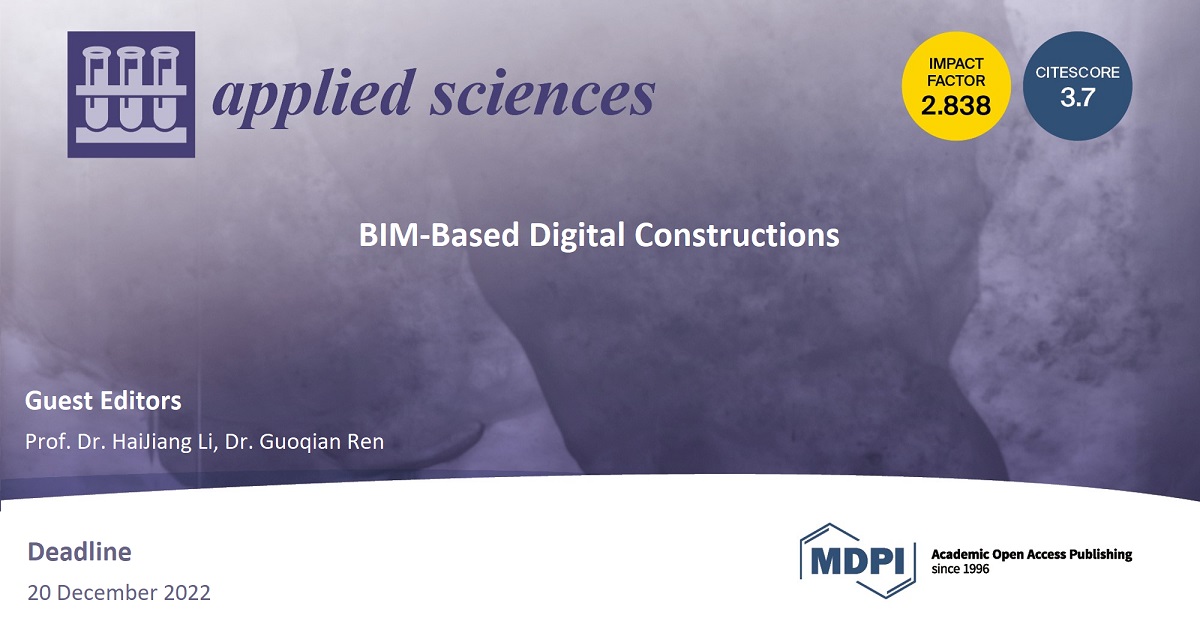BIM-Based Digital Constructions
A special issue of Applied Sciences (ISSN 2076-3417). This special issue belongs to the section "Civil Engineering".
Deadline for manuscript submissions: closed (20 December 2022) | Viewed by 38964

Special Issue Editors
Interests: BIM; digital twins; design automation; knowledge processing; automated code compliance checking
Special Issues, Collections and Topics in MDPI journals
Interests: architecture; big data management; strategy; built environment
Special Issues, Collections and Topics in MDPI journals
Special Issue Information
Dear Colleagues,
The architectural, engineering and construction (AEC) industry is changing its traditional business methods, with information now exchanged digitally rather than in paper form. The development of openBIM concepts does not only focus on the technical aspects, but also covers the joint efforts issues, including the legal, semantic and organizational aspects, to reach a high level of collaboration and integration. Consequently, the topic of BIM should be handled at the digital transformation level.
On the other hand, the concept of a digital twin has been around for several years, a theory based on having a virtual model that simulates the existing situations of the real model, having drawn a lot of interest from researchers. However, the digital twin still requires a framework to follow. BIM, which is a combination of policies, processes and technologies, can support digital twins, for example, by being represented as a digital data management platform able to form the starting point for digital twins. Consequently, BIM and digital twins can complement each other, since bringing such integration can help in testing and simulating different scenarios before execution, which can improve the decision-making process.
However, due to interoperability issues, this integration is still accompanied by several challenges, such as the lack of insight when it comes to an understanding of the structure of BIM and digital twins, the relationships between these concepts, the tools backing their development and the vagueness of how they are linked and what level of integration these concepts are currently at in the AEC industry. Therefore, this Special Issue invites the submission of manuscripts regarding all topics in the form of reviews and original research papers, topics including, but not limited to, the examples addressed above. We look forward to receiving your contributions.
Prof. Dr. HaiJiang Li
Dr. Guoqian Ren
Guest Editors
Manuscript Submission Information
Manuscripts should be submitted online at www.mdpi.com by registering and logging in to this website. Once you are registered, click here to go to the submission form. Manuscripts can be submitted until the deadline. All submissions that pass pre-check are peer-reviewed. Accepted papers will be published continuously in the journal (as soon as accepted) and will be listed together on the special issue website. Research articles, review articles as well as short communications are invited. For planned papers, a title and short abstract (about 250 words) can be sent to the Editorial Office for assessment.
Submitted manuscripts should not have been published previously, nor be under consideration for publication elsewhere (except conference proceedings papers). All manuscripts are thoroughly refereed through a single-blind peer-review process. A guide for authors and other relevant information for submission of manuscripts is available on the Instructions for Authors page. Applied Sciences is an international peer-reviewed open access semimonthly journal published by MDPI.
Please visit the Instructions for Authors page before submitting a manuscript. The Article Processing Charge (APC) for publication in this open access journal is 2400 CHF (Swiss Francs). Submitted papers should be well formatted and use good English. Authors may use MDPI's English editing service prior to publication or during author revisions.
Keywords
- building information modelling (BIM)
- digital twins
- industry foundation classes (IFC)
- buildings and infrastructures
- facility management
- interoperability
- integration
- cutting-edge technologies
Benefits of Publishing in a Special Issue
- Ease of navigation: Grouping papers by topic helps scholars navigate broad scope journals more efficiently.
- Greater discoverability: Special Issues support the reach and impact of scientific research. Articles in Special Issues are more discoverable and cited more frequently.
- Expansion of research network: Special Issues facilitate connections among authors, fostering scientific collaborations.
- External promotion: Articles in Special Issues are often promoted through the journal's social media, increasing their visibility.
- Reprint: MDPI Books provides the opportunity to republish successful Special Issues in book format, both online and in print.
Further information on MDPI's Special Issue policies can be found here.






